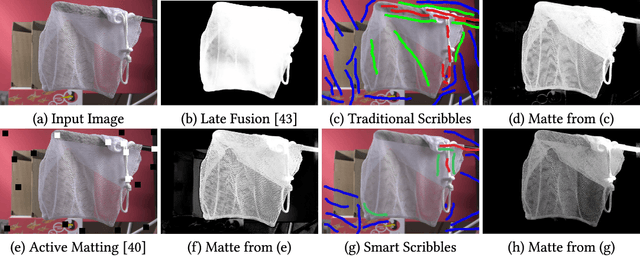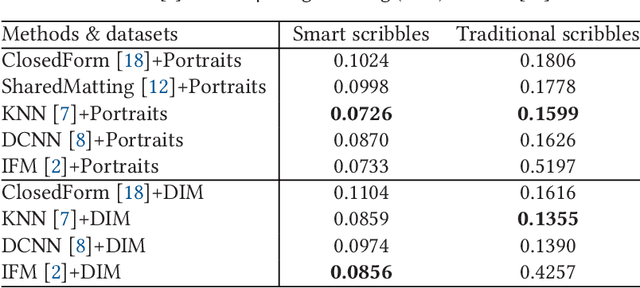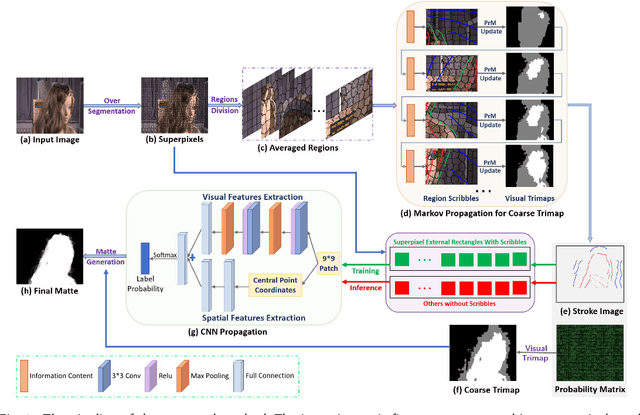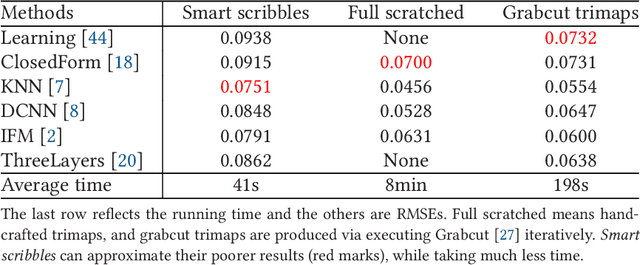Shaozhe Chen
Smart Scribbles for Image Mating
Mar 31, 2021



Abstract:Image matting is an ill-posed problem that usually requires additional user input, such as trimaps or scribbles. Drawing a fne trimap requires a large amount of user effort, while using scribbles can hardly obtain satisfactory alpha mattes for non-professional users. Some recent deep learning-based matting networks rely on large-scale composite datasets for training to improve performance, resulting in the occasional appearance of obvious artifacts when processing natural images. In this article, we explore the intrinsic relationship between user input and alpha mattes and strike a balance between user effort and the quality of alpha mattes. In particular, we propose an interactive framework, referred to as smart scribbles, to guide users to draw few scribbles on the input images to produce high-quality alpha mattes. It frst infers the most informative regions of an image for drawing scribbles to indicate different categories (foreground, background, or unknown) and then spreads these scribbles (i.e., the category labels) to the rest of the image via our well-designed two-phase propagation. Both neighboring low-level afnities and high-level semantic features are considered during the propagation process. Our method can be optimized without large-scale matting datasets and exhibits more universality in real situations. Extensive experiments demonstrate that smart scribbles can produce more accurate alpha mattes with reduced additional input, compared to the state-of-the-art matting methods.
Spatial Attentive Single-Image Deraining with a High Quality Real Rain Dataset
Apr 02, 2019



Abstract:Removing rain streaks from a single image has been drawing considerable attention as rain streaks can severely degrade the image quality and affect the performance of existing outdoor vision tasks. While recent CNN-based derainers have reported promising performances, deraining remains an open problem for two reasons. First, existing synthesized rain datasets have only limited realism, in terms of modeling real rain characteristics such as rain shape, direction and intensity. Second, there are no public benchmarks for quantitative comparisons on real rain images, which makes the current evaluation less objective. The core challenge is that real world rain/clean image pairs cannot be captured at the same time. In this paper, we address the single image rain removal problem in two ways. First, we propose a semi-automatic method that incorporates temporal priors and human supervision to generate a high-quality clean image from each input sequence of real rain images. Using this method, we construct a large-scale dataset of $\sim$$29.5K$ rain/rain-free image pairs that covers a wide range of natural rain scenes. Second, to better cover the stochastic distribution of real rain streaks, we propose a novel SPatial Attentive Network (SPANet) to remove rain streaks in a local-to-global manner. Extensive experiments demonstrate that our network performs favorably against the state-of-the-art deraining methods.
 Add to Chrome
Add to Chrome Add to Firefox
Add to Firefox Add to Edge
Add to Edge